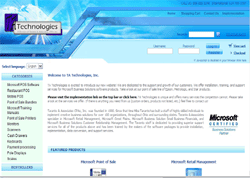Inventory Management using Point of Sale Software
Inventory Management using POS Software
When you first started your retail shop and it was just you selling, stocking, ordering, and doing the books, you knew what was selling. When you added your first employee and trained them to run the register you took your first step towards being a manager. A manager cannot be hands on in every function of the store to be successful. You then need to rely on the systems you put in place. This is where your POS system can help.
Your POS system, when used correctly, allows you to track what you sell and buy. When a customer purchases a item the system will record the reduction in quantity. When you receive a purchase order, the quantity is increased. Pretty easy stuff. When your business gets to be well known that same customer may be purchasing 5-10 items and the line is 5 deep. We may have sold 200 items today and had 3 suppliers send fulfilled orders via UPS, Fedex, and DSL. You couldn't do it all and after a week of this you don't know which end is up. What do you do?
The first step is to create your business processes and be consistent. Some examples would be:
Check Out
1) Gathering information on customers at check out.
2) How you check out and package orders.
3) How payments are accepted and processed.
4) Marketing to the customer (Pole Displays, customer facing screens, coupons, etc.)
Receiving & Stocking
1) Receiving product and generating labels.
2) Checking pricing versus the issued purchase order
3) Checking quantities versus the issued purchase order.
4) Timing in getting the product to the shelves.
Purchasing
1) How to determine quantities needed
2) Create the Purchase Orders
By creating these processes and following them will allow you to use your point of sale system to assist you. With each item in the system you will be generating sales and purchase history. In most systems, each item can have information added to help you manage quantities and orders. Take a look to see if there are fields such as reorder level, maximum order amount, minimum order amounts, lead time, and others. These fields will allow you to automate your purchasing. This is usually the longest part of implementing the inventory management system. Armed with this information most systems will "suggest" what you should purchase. This report will take a look at your quantity on hand and compare to your reorder level. You then can create the purchase orders in mass using a generator utility, saving you time. These purchase orders will then help you manage the next step.
When the vendors ship you the product from your purchase orders you now have a tool to hold them accountable. When the product comes in you will now be able to enter in the details of the receipt. Date and quantities are the norm. You will then be able to keep record of lead time and quantity over/short. When the vendor send the matching invoice you will be able to track actual price to expected. Reports can show you price variances from what you expected, giving you the tools to verify pricing. By creating a purchasing system you will ensure that you get what you order at the price you ordered it in the timeframe you wanted it.
Selling your products has its own issues. Making sure that pricing is accurate, sales are managed, and price breaks are honored are some of the challenges you face. Using your system you should be able to correctly set the pricing for each item. Adding custom pricing is also important and should looked at during software selection. Being able to buy X and get Y free can help you move inventory. Having the ability to give price breaks based on quantities sold can also be important for bulk sales.
Barcoding your inventory is also recommended. On most products you will have a UPC label that you can use. Generating your own label through your software should also be available. A barcode is nothing more than a font that displays your item number in lines. Making sure that all your products have barcodes makes sure that the cashiers sell the right item for the right price. Because some items are similar, the barcode makes it closer to error free.
The system you choose needs to be able to help you make the right decisions. As you grow using the "seat of your pants" management will disappear and you will need information in order to please your customers and for you to make a profit. Evaluate the ability of your system in selling and purchasing your products and managing the processes you develop.
Good Luck!
Michael J. Taranto, CPA
866-469-6043
866-469-6043

